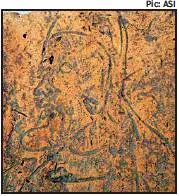‘Foreigner’ with skull cap unearthed in 6th-century Vishnu temple in MP
The discovery of a mysterious ‘foreign face’ engraved on a brick in a 6th-century temple in MP’s Singrauli has created a sensation among archaeologists. The engraving, of a bearded man in ‘foreign attire’ and a skull cap, was found in an early Kalachuri Dynasty temple at an ASI dig site in Nagwa area. Researchers have no idea whose face it depicts.
RARE 6TH CENTURY FINDS IN MP
A brick with a bearded face, a skull cap and foreign attire have been unearthed during an excavation of a 6th century Kalachuri Temple at Nagwa in Singrauli (MP) by the ASI, Bhopal. Among the other rare finds is an idol of Vishnu (above), which has a drum tied to the waist
“Thismeans that a foreigner was allowed into the religious activities of the day. Such examples are extremely rare,” superintending archaeologist Dr Madhulika Samanta, who is leading the excavation, told TOI. “Clothes of this type were not worn by people of the region those days. The drawing shows the presence of such a person at a Vishnu shrine. The attire and features indicate a resemblance to such things found in West Asia,” she added.
The closest example is the ‘Heliodorus Pillar’. The 6.5m stone column was built around 113 BCE in Vidisha’s Besnagar by Heliodorus, an ambassador of Indo-Greek king Antialcidas of Taxila to the court of Shunga king Agabhadra.
This site was discovered in July 2018 when ASI was alerted about “villagers carrying away bricks from a mound”, which turned out to be the temple’s garbhagriha. What has emerged after excavation is a statue of Vishnu so unique that only a handful exist. It has a drum tied to the waist, and the left hand resting as if He were playing it.
It probably indicates the influence of ‘Matta Mayuri’ cult — which propounded an amalgamation of other cults, such as Vaishnava and Shakta, within the Shaiva cult, say ASI officials. The statue is also holding a ‘Beejapuraka’ (grapefruit). So far, ‘Vishnu with Beejapuraka’ images have been found from Pala Period (9th-10th Century CE), but this statue is the oldest ever found.
Full report on www.toi.in
A brick with the face of a ‘foreigner’. Clothes of this type were not worn by people of the region in those days








No comments:
Post a Comment